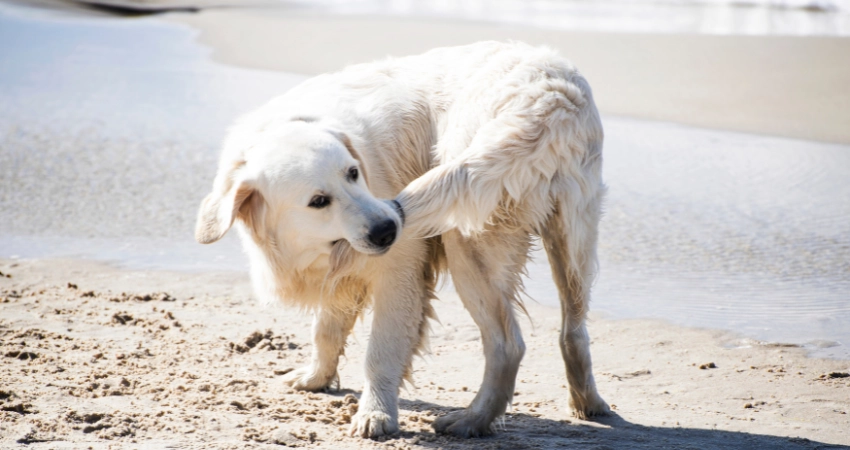Many pet owners are eager to know why dogs chase tails, as it truly is a fascinating behavior. However, what many may not realize is that this could be a sign of underlying issues.
This behavior is often seen as playful fun or a way for pets to entertain themselves. However, there’s much more behind this seemingly harmless practice that can reveal details about the physical and mental health of our four-legged companions.
Up next, we’ll explore the various explanations for why dogs chase tails, discussing natural reasons as well as problems that may require veterinary attention. Stick around to discover how to interpret what your dog is trying to convey when engaging in this peculiar activity.
Why dogs chase tails: Understanding the behavior
Chasing their own tail is a behavior commonly observed in many dogs, especially when they are puppies. During this stage, dogs are constantly exploring their surroundings, and their own tail can become a “toy.” In this sense, this act is simply a way to explore their own body.
However, even in adult dogs, this behavior may be a way to relieve boredom. Many dogs have excess energy and, if they don’t get enough physical and mental stimulation, they might start chasing their tails as a pastime.
In other cases, this could be a reflection of learned behavior, especially if the dog notices that this action draws their owner’s attention. On the other hand, why dogs chase tails may also be linked to health issues.
In some situations, the obsession with biting or chasing the tail could indicate that the dog is dealing with pain, allergies, or parasites like fleas and ticks that cause intense itching.
The Search for Attention and Entertainment
Dogs are highly social animals and often seek ways to attract the attention of the humans around them. When a dog realizes that chasing its tail results in laughter, affection, or even reprimands, it may continue with this behavior as a form of interaction.
A lack of toys and stimulating activities in the pet’s daily life can also lead to this habit. Dogs that spend long periods alone or in monotonous environments may develop repetitive behaviors, like chasing their own tail, to entertain themselves.
Additionally, some dogs develop this behavior as a way to release pent-up energy. Breeds with high energy levels, such as Border Collies and German Shepherds, are especially prone to displaying repetitive behaviors if not properly exercised.
Genetic and Behavioral Factors
There’s also a potential genetic explanation for why dogs chase tails. Some breeds are more prone to developing compulsive behaviors, like Dobermans, which have a predisposition to “hunt” their own tails. This could be related to a combination of genetic factors and environmental stimuli.
Moreover, dogs that suffer from anxiety or stress may resort to this behavior as a way to calm themselves. Just as humans might bite their nails or tap their feet in moments of nervousness, tail chasing can be a response to stressful situations.
It’s important to observe if your dog exhibits this behavior at specific times, such as when there are changes in the environment or exposure to loud and unfamiliar sounds. In these cases, it is crucial to identify the source of the anxiety and find ways to soothe your pet.
Why dogs chase tails: Medical and Health Issues
In some cases, why dogs chase tails may be related to health problems that require veterinary attention. For instance, inflammation at the base of the tail, skin allergies, or flea infestations can cause discomfort and lead the dog to try to bite or reach its own tail.
Another significant factor is obsessive-compulsive disorder (OCD), which can affect some dogs. Similar to humans, dogs with OCD may engage in repetitive and incessant behaviors, like tail chasing.
This disorder can be exacerbated by a lack of mental or physical stimulation and is often seen in dogs that spend long periods alone or in restrictive environments.
Therefore, if your dog is intensely and constantly chasing its tail, it is essential to consult a veterinarian for an accurate diagnosis. This way, medical conditions can be ruled out, and the best solutions for your pet’s well-being can be found.
The Impact of Diet and Environment on Dog Behavior
Another factor that might influence why dogs chase tails is the animal’s diet. Poor nutrition can affect dog behavior, leading to hyperactivity or, conversely, compulsive behaviors. Foods high in sugars, artificial colors, and additives can cause energy spikes and, in some cases, anxiety problems.
Ensure that your dog is receiving a balanced diet rich in proteins, vitamins, and minerals. Providing high-quality food can significantly contribute to your pet’s physical and mental health, reducing the need to seek “self-entertainment” through repetitive behaviors.
In addition to diet, the environment in which the dog lives plays a crucial role. A stressful environment, with excessive noise, limited social interaction, and a lack of space to move around, can lead the dog to find ways to cope with stress. Creating a safe, comfortable, and stimulating space for your pet can help minimize behaviors like tail chasing.
The Role of Socialization and Training
Proper socialization from a young age is essential to prevent undesirable behaviors like tail chasing. Dogs that are exposed to different stimuli, play, and interactions are less likely to develop repetitive behaviors, as they learn to channel their energy positively.
Training your dog with basic commands is essential. Enriching the environment with interactive toys and regular walks can also help keep your pet mentally stimulated. This can significantly reduce the habit of tail chasing, especially if it is caused by boredom or a lack of exercise.
It’s important that owners avoid encouraging this behavior with laughter or excessive attention. Dogs may learn that tail chasing is an effective way to get noticed.
How to Prevent Your Dog from Chasing Its Tail
If you notice that your dog frequently chases its tail, it’s important to understand why dogs chase tails and implement strategies to help control this behavior:
- Increase activity levels: Ensure your dog gets enough daily exercise. Walks, runs, and playtime help burn off energy and keep your pet mentally healthy;
- Provide interactive toys: Enriching the environment with toys that challenge your dog mentally can reduce the need for repetitive behaviors;
- Training and basic commands: Teaching commands like “no” or “stop” can help redirect your dog’s focus when they start chasing their tail.
When to Consult a Veterinarian
It’s always good to observe your dog’s behavior to understand when something might be wrong. If your pet is obsessively chasing its tail, especially if it started suddenly, it’s important to seek a veterinarian.
Here are some warning signs indicating that you should seek professional help:
- Frequency: If your dog is chasing its tail multiple times a day for extended periods;
- Injuries: If they start biting their tail to the point of causing wounds or bleeding;
- Behavioral changes: If your dog appears more irritable, anxious, or agitated in addition to chasing its tail.
A veterinarian can run tests to rule out medical conditions like infections, parasites, or neurological issues. They can then recommend the best treatment for your pet.
Why dogs chase tails: Understanding What Your Dog is Communicating
Ultimately, understanding why dogs chase tails is a way to connect more deeply with our four-legged friends. Whether due to boredom, pent-up energy, attention-seeking, or health issues, this behavior reveals a lot about your pet’s physical and emotional state.
Maintaining a balanced routine of exercise, socialization, a healthy diet, and regular vet visits is key to ensuring your dog lives a happy and healthy life. Pay attention to the signs they display and always be willing to adapt your care practices to promote your companion’s well-being.

